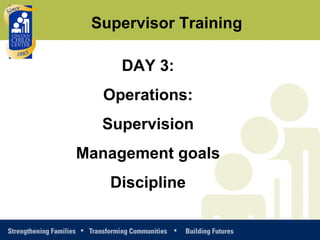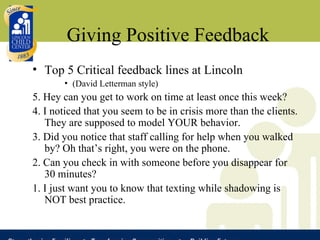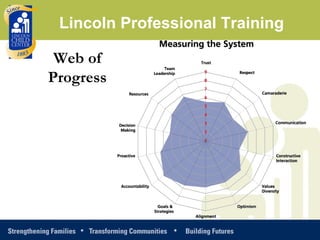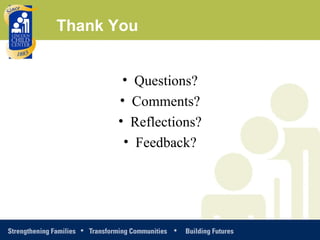Lpt management training day 1 4
- 1. Management Training Series Going from good to great as a manager and a leader Molding your style through promising practices Macheo Payne Lincoln Child Center 2011 Lincoln Professional Training
- 2. DAY 1: Leadership Theory - The nuts and bolts of being a manager. leadership theory & strengths assessment and building relevance. DAY 2: Managing People - Building and strengthening the team, working with staff from strengths-based perspective DAY 3: Operations - Goals as a manager, agency leadership discussion with Chris, Supervision, HR/ employee relations (progressive disciplinary process) DAY 4: Bringing It All Together - Developing overall philosophy and strategy as a manager, The Cloud, revisits, recaps & wrap up Lincoln Professional Training
- 3. Trainings will involve: Role plays, case studies, vignettes Thinking through and discussion real problems for managers at Lincoln Applying the lens of diversity issues and societal dynamics of oppression Lincoln Professional Training
- 4. DAY 1: Goals -Explore practical skills, strengths in the room Review primary aspects of management Review leadership models Lincoln Professional Training
- 5. Diversity in Leadership Race, Class Gender, etc. Lincoln Professional Training
- 6. Diversity Issues The Social diseases: Race, class, gender, ethnicity, culture Bias - Automatic, universal & constant. Simply be aware. Stereotype - True until personally disproven. Cannot be addressed if denied. Assumption - Function of efficiency. Effective with natural world, highly ineffective with social sciences. Hidden from self until consciously acknowledged, typically through reflection Comfort level - Always present but only accessible if you “check-in” and reflect Lincoln Professional Training
- 7. Diversity Issues Culturally responsive management 1. Diversity issues, cultural differences, sexual orientation (do you disclose someone’s orientation to another staff? Even if they are openly gay?) 2. Race issues, institutional racism, and it’s manifestations 3. Gender bias & gender issues in the workplace 4. Differently abled 5. American Race activity 6. Being a target of discrimination or any of the isms. SHARING: Share experiences and how you dealt with them and how would you deal with them as a manager? 7. Hostile work environment? What if your boss is hostile? What if your staff is hostile? How to give direct feedback even if you are scared and how to protect yourself. Lincoln Professional Training
- 8. The Strength of Diversity The pathology lens of children and youth is not actually helpful for healing. Adults can be viewed similarly from a Strengths based perspective. Paradigms of Progress Win-Win Win Lose Positive Sum Game Zero Sum Game Cooperation Competition Unlimited Resources Scarcity, finite Resources The circle The ladder Lincoln Professional Training
- 9. Leadership Models Servant Leadership The Tao of Leadership Win Friends & Influence People One Minute Manager Good To Great Leadership Jazz Lincoln Professional Training Lincoln Professional Training
- 10. Lincoln Professional Training Leadership Framework for Transformation LEADERSHIP JAZZ Max DePree Leadership Jazz emphasizes symbolic forms like story, metaphor, and music. The symbolic frame, drawing on social and cultural anthropology, treats organizations as tribes, theaters, or carnivals. It abandons the assumptions of rationality more prominent in the other frames. It sees organizations as cultures, propelled more by rituals, ceremonies, stories, (s)heroes, and myths than by rules, policies, and managerial authority. Organization is also theater: actors play their roles in the organizational drama while audiences form impressions from what they see onstage. Problems arise when actors play their parts badly, when symbols lose their meaning, when ceremonies and rituals lose their potency. We rebuild the expressive or spiritual side of organizations through the use of symbol, myth, and magic. EXAMPLE: Your program is a pot of stew. Culture (rituals, symbolism, metaphor, narrative) is the liquid in the stew, and form & function (policies, procedures, tasks, roles, goals and objectives) are the contents of the stew. As the leader, you stir the pot, add ingedients, taste, add fire, let simmer, etc. What is YOUR metaphor?
- 11. Lincoln Professional Training Leadership Jazz: 4 Frame Model
- 12. Logic Model Lincoln Professional Training
- 13. Logic Model Lincoln Professional Training
- 14. Hidden Rules of Class at Work Questions 1 . What resources do you bring? 2. What connections (relationships) do you bring? 3. What are your hidden rules? (assumptions, expectations, work style, professional integrity, resource management, work ethic, etc.) Lincoln Professional Training
- 15. Hidden Rules of Class at Work Examples of Rules 1. There are no “little people” 2. If I was in their shoes… 3. Interest convergence, ( all conflict is a misunderstood benefit) 4. There is no such thing as an absolute friend or foe 5. The little things make the big things happen 6. Working with purpose, passion & reflection yields more outcomes and impact than doing as many things as fast as possible 7. The process is just as important as the outcome because it determines the quality of the outcome Lincoln Professional Training
- 16. Management and Leadership: 3 Jobs in One “ The only person you can ever manage or lead effectively is yourself, and even then, you have a lot of convincing to do.” 1. Manage and lead yourself (principles, values, philosophy, time, priorities, thoughts, feelings, motivation, drive, determination, transformation, advancement, etc.) 2. Manage your duties, workload (calendar, schedule, assignments, tasks, work, etc.) 3. Manage relationships (supervise people, work with them, influence, guide, direct, support, encourage, inspire, coach, praise, appreciate, acknowledge, honor and respect) Lincoln Professional Training
- 17. Your Leadership Philosophy 1. Epistimology of Western Society: What we think we know and why we think we know it (core assumptions about life, death, reality (for instance: Western ideas of seperation between mind & body, western promoted host of binaries: good bad, victim perpetrator) 2. Ontology of a wholistic worldview: What happens in the world will always be a problem if we see it as something outside of ourselves. How we view the world and our connection to it is the problem AND the solution. Lincoln Professional Training
- 18. DAY 2: Managing People: Strengths-based teambuilding Lincoln Professional Training
- 19. Comic Relief
- 20. Difficult Conversation. Staff Splitting. How to build leadership & responsibility. Sharing Information, fostering competence. Lincoln Professional Training
- 21. Boundaries Personal Boundaries (Personal comfort zone) Personal business Privacy (TMI) Personal beliefs Professional Boundaries (Conduct as a supervisor) Attitude Gossip Appropriate discussion Outside affiliation with staff & families Harassment Solicitation Client Boundaries (conduct with clients) Physical space Outside contact Social networking Favoritism Giving money Over identify Too casual or informal
- 22. Boundaries
- 23. Boundaries Personal Boundaries Keeping your personal life separate from your work environment is important. Examples: Keeping personal information to yourself Not allowing personal issues & challenges infringe on your ability to perform at work Not using your time at work to deal with personal issues not related to the job Talking about your personal habits, vices, adult behavior, etc. Restrict Facebook settings
- 24. Boundaries
- 25. Boundaries Professional Boundaries Finding the balance between being personable and remaining professional is critical. Always default to a professional demeanor and establish rapport after boundaries are clearly defined and established. Examples: Maintaining professional demeanor, dress, language, communication & conduct at all times while at work Responding appropriately to challenges on the job despite personal feelings or inclination to respond differently Developing relationships with other staff, contractors risky and blur the line Prevent Staff Splitting
- 26. Boundaries
- 27. Boundaries Client Boundaries Clients cross boundaries often. It is the responsibility of the staff person to establish and reinforce appropriate boundaries at all times. Examples: Keeping appropriate physical boundaries with clients; no touching, hugging or physical playfulness with clients Don ’ t give gifts, money, gum, resources, etc. unless it ’ s a part of the program Keeping emotional boundaries in all interactions; be aware of favoritism clients liking you or you Keeping appropriate social boundaries Not over identifying with clients Not interacting too casually with clients Not allowing clients to interact to familiarly or casually with you or in your presence (always acknowledge inappropriate behavior or language)
- 28. Staff Splitting 3 Forms of Staff Splitting “ They” Paradigm Criticizing up, down or sideways. In an effort to support one staff, you criticize other staff. Empowering critical feedback is ALWAYS direct, discreet, & supportive. The Indirect-Comparison Compliment ‘ So and so ’ never made us do that. She just let ’ s us do it later. (and things worked just fine that way) The Dry “ Snitch ” Sorry I didn ’ t get back to you but I was waiting on ‘ so and so ’ to send me his edits first.
- 29. Anti-Splitting Combat Splitting The Direct Qualitative Compliment (backhand) Well to be fair, ‘ so and so ’ I am sure we don ’ t have all the information about … The Indirect-Comparison Compliment I know that this is the current expectation and how can I help you meet it? The Dry snitch Given that, how can we move forward? What ’ s the best way?
- 30. Morale Boosters “ How Can I Help? ” Create a control plan for negativity. Negativity is not healthy to the agency or us as individuals. Dispell the “ Myth of Management ” by distinguishing truth from perception, fact from myth. Encourage staff supporting each other and being empowered to respond to situations. Foster and encourage multiple avenues of constructive, productive communication and collaboration within the agency. This can be critical yes, but condemning or blaming, no.
- 31. Morale Boosters
- 32. Morale Boosters Open Communication Be realistic and focus on strength-based, performance-based language Try: These are difficult changes and we can talk about the impact as well as how we will continue to improve. Not: Yeah, this is bad and I don ’ t know what ’ s really going on or what is happening.
- 33. Morale Boosters
- 34. Morale Boosters Being Onboard First Reflect on your own concerns Try: Setting aside time to reflect and identify top concerns to address and find appropriate ways to address them. Ask yourself: What is the best solution? How can I support staff and eliminate any splitting or ‘ us and them ’ binaries. Remember the principles: Going above and beyond is the standard of Excellence
- 35. Morale Boosters
- 36. Morale Boosters Accountability With positive presupposition, beware of Deflection. If a staff deflects, determine if it is directly related to what you are asking them to do. Hostility. “ This is just not fair, things are crazy around here, etc. ” Challenge them to be very specific and accurate and personal. Not including others not present. Vicarious trauma. EAP, HR. If it ’ s unacknowledged, contrast feelings and general sense from actual events.
- 37. Morale Boosters
- 38. Morale Boosters Attitude and Climate Model, don ’ t mirror Encourage. You risk being one of them or being out of touch but mirroring negativity eliminates the “ adult ” from the interaction. Ask Questions. What do you mean? Do we know that for certain? What does that mean for you? What was the context? Typically people have half the story and it fair to point that out so we can move forward. Recast & reframe. With principles in mind (guarding against sarcasm but using humor appropriately), restate the issue from a more fair balanced point of view as if others were present. Redirect. Subtle or not so subtle redirection to strength based, performance-based focus is the most helpful.
- 39. Morale Boosters
- 40. Morale Boosters More do ’ s & don ’ ts Avoid threats. You are lucky to still have a job, etc. It doesn ’ t inspire. Share good news . Instead appreciate and ask permission to share Stay focused. Keep in mind what your goals are with staff and base interactions on them. Be positive. Contrast challenging changes with positive improvements, changes and opportunities.
- 41. The Motivation Matrix Lincoln Professional Training
- 42. The Motivation Matrix Lincoln Professional Training
- 43. Motivating Staff SOLIDARITY or GUILT: Is doing their job your job? Do NOT motivate staff by doing their job to show them solidarity. You can step in fulfilling their functions periodically when it is in the best interest of clients, the program and a wise use of your time at that moment. Lincoln Professional Training
- 44. Supervisor Training DAY 3: Operations: Supervision Management goals Discipline
- 45. Introductions How long have you been a supervisor? How many people have you supervised? hired? etc? Favorite part about being a supervisor? Superman versus Supervisor
- 46. What is your biggest challenge with Staff? Your role? What do you do best? Where can you improve? Superman versus Supervisor
- 47. REFLECT 1. How many supervisors have you had? 2. Which one helped you grow and get better? 3. Which one did you hate/love the most? 4. Which one do you want to be like? Superman versus Supervisor
- 48. Headline: Superman get ’s overwhelmed by the Legion of Doom! Common Misconceptions about Great Supervisors Constant Availability Having all the answers It is better to fix a problem yourself rather than letting others stumble Learning from the gifted master counselor is the best teaching tool Being well liked is crucial to success Superman versus Supervisor
- 49. Headline: Our Superheroes Find The Secret Syrum! Antidotes To Misconceptions Consistent Schedule, superb time management Asking good questions that empower the staff to have all the answers Empowering staff to take responsibility is how you duplicate yourself Learning from ones own mistakes is the best tool Being liked doesn ’t = being respected as a leader. People can like you for many different reasons but you can only be respected as a leader for helping others perform better Superman versus Supervisor
- 50. Structuring Supervision Supervision Reduces Crisis Management! Meet consistently – crises interrupting only create more crises Set expectations at the beginning Goal setting: staff input & your observations equally important in this step Introduce a structure AND follow it Example: Billing, hot clients, team issues, etc will be discussed every week Always allow time for supervisee driven topics
- 51. Structuring Supervision Inform supervisee that you will take notes Review last week ’s notes right before next supervision
- 52. Pitfalls/Solutions in Supervision Problem: Staff ’s need to process challenges with clients morph into staff’s need to process challenges in personal life. How to balance being supportive without turning into therapist Solution: 1 st : Continue to bring conversation back to how this impacts work with client 2 nd : Consult with supervisor or colleague before next supervision 3 rd : Refer to EAP (Have phone number memorized!)
- 53. Pitfalls/Solutions in Supervision Problem: Staff are unable to generalize previous problem solving sessions to new problems. Solution: Provide problem solving model for staff to utilize before coming to you Example: IDEAL problem solving method
- 54. Pitfalls/Solutions in Supervision Problem: You have to give tough feedback to staff. Solution: Do not postpone. Problem is not going to go away. Person deserves feedback for their own growth. Get support & practice with teammate or supervisor Start from the perspective that you believe the person ’s intent was good & help them understand that impact still matters regardless. People do the best they can with the resources they have, so give them tools to do it another way.
- 55. Giving Positive Feedback Headline: The Riddler Leaves Staff Guessing About Their Performance Do this frequently (thank them for showing up to work) Feedback is a critical component of supervision and the primary way staff improve, not to mention essential for morale. Be specific and accurate (don ’t generalize or praise the wrong person) Be genuine (don ’t force it. Let the appreciation bubble up from within) Do it in the moment (don ’t wait for a “better” time) Do it openly (but not sarcastically or in comparison to others)
- 56. Giving Positive Feedback Top 5 Critical feedback lines at Lincoln (David Letterman style) 5. Hey can you get to work on time at least once this week? 4. I noticed that you seem to be in crisis more than the clients. They are supposed to model YOUR behavior. 3. Did you notice that staff calling for help when you walked by? Oh that ’s right, you were on the phone. 2. Can you check in with someone before you disappear for 30 minutes? 1. I just want you to know that texting while shadowing is NOT best practice.
- 57. Difficult Feedback: The 3 Conversations 1. The “What Happened?” Conversation. Most difficult conversations involve disagreements about what has happened or what should happen. Who said what and who did what? Who ’s right, who meant what, and who’s to blame? What is perceived to have happen must be examined and verified or corrected. TIP: Repeat and rephrase to highlight facts, and exclude judgement. 2. The Feelings Conversation. Every difficult conversation also asks and answers questions about feelings. Are my feelings valid? Appropriate? Should I acknowledge or deny them, put them on the table or check them at the door? What do I do about the other person ’s feelings? What if they are angry or hurt? How you feel almost always determines what you perceive happened and what the intent was. In other words, it is very difficult to feel hurt and still perceive good intent. TIP: Feelings are important. Sometimes more important than facts so be considerate. 3. The Identity Conversation. This is the conversation we each have with ourselves about what this situation means to us. We conduct an internal debate over whether this means we are competent or incompetent, a good person or bad, worthy of love or unlovable. What impact might it have on our self-image and self-esteem, our future and our well-being? Our answers to these questions determine in large part whether we feel “balanced” during the conversation, or whether we feel off-center and anxious. This is the end result feeling/assumption of what we are feeling, the core of what the conversation represents for us personally. TIP: It IS personal so don ’t pretend it isn’t, just emphasize the professional aspect.
- 58. Giving Difficult Feedback Ask them if you can give them some feedback Make eye contact and start with an “I” statement OR a compliment on performance. INSTEAD OF: “Hey come here, I need to talk to you, I saw you talking about client X momma. Don’t ever let me catch you doing that again. TRY: “Hey Macheo, can we check-in? I noticed how you were joking around with client X. That’s totally appropriate as long as it stays light and positive but when they talk about your momma, don’t return fire. Try disengaging or telling them that’s inappropriate.”
- 59. Receiving Difficult Feedback Ask for feedback: Take feedback, not personal attacks Example: “How can I do a better job of supporting you Macheo? Well you can start by letting me do my job and quit harassing me, taking the kids side all the time, etc.” INSTEAD OF: “What? I always got your back! You’re the one cutting out not doing your job.” TRY: “Thank you for sharing your thoughts but, I need you rephrase that so there is no blame and so I can be helpful. Start with a specific example.”
- 60. Progressive Disciplinary Process “ If you do that ONE more time…” HIGHLIGHTS: The top 3 rules with the PDP are: 1. Check in with HR 2. Consult with HR 3. Notify with HR Keep your supervisor informed Direct, clear and consistent feedback is the best prevention for the PDP. REMEMBER: Problems that develop with staff NEVER go away on their own.
- 61. Time Management Headline: Time Is Running Out For Our Superheroes! Elements of Keeping Track of Your Precious Time Assess: Do a 30 min. time audit of a day Layer: Block out regularly scheduled meetings and let everyone know Prioritize: Prioritize the most important tasks and let everyone know Eliminate: Identify lowest priority tasks and duties to reduce or eliminate
- 62. Time Management The Best Way To Say “ NO ” Prioritize when there is a conflict Predetermined priorities will decide, not you Negotiate or renegotiate Take 1 minute to talk through creative options Consult your supervisor Check with others to build support & buy in Calibrate expectations of your involvement Get clear on what you are being asked and what you can offer
- 63. Email Management Email Communication Email pet peeves: I didn ’ t get your email! Responses & replies: replies help, even to say thanks or got it. Supports accountability The angry email: don ’ t do it, call instead or face to face Group emails: Read them carefully, identify what you want passive recipients to do with info Transferring info: pen handy Email retrieval: archive, folders, searches Before sending: proofread, reread Serial Cc ’ er: exclude after relevant parties engage
- 64. DAY 4: Developing Philosophy. Bringing it all together. Lincoln Professional Training
- 65. Goals - Review Team Models Productivity Morale Balancing the two Cultural Responsiveness Using Ritual to Deepen the Work Lincoln Professional Training
- 66. Introductions Lincoln Professional Training
- 72. Boosting Productivity Lincoln Professional Training
- 73. Boosting Morale Lincoln Professional Training
- 74. Lincoln Professional Training Lincoln Professional Training
- 75. Web of Progress Lincoln Professional Training
- 76. Measuring Morale & Productivity Lincoln Professional Training
- 79. Assessment & Diagnostic Tools Search the Net for complimentary resources but don’t be afraid to use resources to get useful tools that will have a significant impact “ Morale Assessment Tool” http://www.examinationsecrets.com/scube%20download/S-CUBE%20MORAL%20ASSESSMENT%20TEST.pdf Lincoln Professional Training
- 80. Agency-Program-Alignment Lincoln Professional Training
- 81. Blank Lincoln Professional Training
- 82. Blank Lincoln Professional Training
- 83. Blank Lincoln Professional Training
- 84. Blank Lincoln Professional Training
- 85. Thank You Questions? Comments? Reflections? Feedback?






















































































